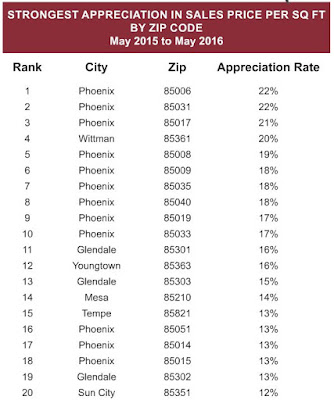The Census Bureau Quickfacts table for Arizona has some interesting statistics.
The total population estimate for July 1, 2015 is stated to be 6,828,065. This is up 1.4 % from 6,731,484 on July 1, 2014, Although this represents a total of 96,581 added to Arizona's population in 12 months it is also a lower percentage rate than many would like to see. Population growth fuels the economy, especially the economy tied to housing. The population figure for April 1, 2010 (census count rather than estimate) is 6,392,307. We have therefore seen a growth of 435,758 in just over 5 years, or 6.8%. This is better than many other states but far below the rates of growth that Arizona experienced between 1945 and 2007.
The balance in the population has been shifting dramatically away from children and towards retirees. The percentage of the population by age group changed as follows between April 1, 2010 and July 1, 2014:
- Persons under 5 years of age - down from 7.1% to 6.4% - a 10% fall in just over 4 years
- Persons under 18 years of age - down from 25.5% to 24.1% - a fall of 5.5% in just over 4 years
- Persons 65 years and over - up from 13.8% to 15.9% - a rise of over 15% in just over 4 years
So although we added 339,177 people between April 1, 2010 and July 1, 2014, we ended up with 23,039 fewer children under 5 and 7,751 fewer children under 18. At the same time we added 188,168 people aged 65 and over and158,760 people between 18 and 65.
We may be in danger of following in the footsteps of Japan with plummeting fertility rates and falling school head counts.
_________________________
Comment: The fact that countries need young, productive producers to fuel their economies is something you don't hear talked about that much about in our current political and security sensitive environment. But this need for 'workers' and in our world 'buyers' is a factor in government immigration policies around the globe.
This is detailed in an interesting book by Harry Dent - The Demographic Cliff - where he speaks to what's going on in Japan and other European nations soon to follow suit - the consequence of falling populations, and also helps explain the fall-off in commodity prices (deflation) that Mike Orr (Cromford Report) has also observed.
On the flip side, relative to housing, nationwide there is a housing shortage - as we're not building fast enough to keep up with the population growth. As the millenials continue to buy more homes this will become even more manifest and of course is evidenced locally in the lack of lower-end inventory and subsequent rapid appreciation in that market sector.
Lawrence Yun, NAR Chief Economists speaks to this in your most recent REALOR Magazine in his article 'If you build it, they will come', where he notes that U.S. homes sales are trending at 5.07 million units per year (demand), yet their are only 1.88 million active listings - a 4.5-month supply.
The first highlighted number in the Cromford Daily Observation above (adding 188,168 people aged 65 and over) helps explain the downsizing we're witnessing in the luxury sector.
The second highlighted number (adding 158,760 people between 18 and 65) is at least on the plus side.
I guess we need to encourage the millenials to both buy homes AND have babies. I have a son and daughter who have made contributions in the last 4 years, so we're doing our part:)










